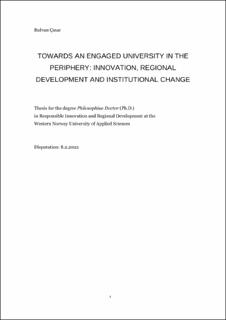| dc.description.abstract | The increasing visibility of the impact of various societal challenges, such as climate change, territorial disparity, income inequality and demographic change, has brought the role of innovation to the fore of academic and policy debates. Universities are increasingly expected to mobilise their resources to address these societal challenges through innovation, thereby contributing to regional development. Such expectations are particularly high in peripheral regions generally characterised as having a weak institutional landscape. The complex nature of societal challenges, however, pushes universities to diversify the scope of innovation-related third mission activities. This requires moving beyond traditional regional engagement modes such as technology transfer and industry collaboration towards engaging with other types of innovation (e.g., social) and societal partners (e.g., municipalities and citizens) as well. This is a transformation from mainly an economically oriented third mission ingrained within the entrepreneurial university to a new one involving socially, environmentally and culturally oriented regional engagement as well, which generally manifests within the engaged university model.
While the relevant literature has advanced understanding of the way universities can become engaged, the insights have largely been limited to the context of core regions. This thesis therefore aims to explore the extent to which higher education institutions located in peripheral regions can achieve adopting the engaged model and more importantly, how a transformation from the entrepreneurial to the engaged university takes place in such regions. Here, transformation from the entrepreneurial to the engaged university is conceptualised as an institutional change process, which is further scrutinised through the following three research questions: i) What are the characteristics of individual and organisational efforts geared towards transformation into an engaged university in a peripheral region? ii) Under what conditions can universities located in peripheral regions transform from the entrepreneurial to the engaged model? ii) What are the institutional and organisational challenges universities face while transforming from the entrepreneurial to the engaged model?
This thesis mobilises five key concepts within institutional theory by delving into the institutional change process of universities: critical juncture, institutional complexity, institutional logics, legitimacy and level of structuration—or degree of institutionalisation. It adopts a qualitative multiple case study design: two public universities located in peripheral regions in the Netherlands and Portugal. The main data utilised were 73 semi-structured interviews and 346 policy documents. The data analysis resulted in five papers that collectively contribute to answering the research questions.
A significant overall finding of the thesis is that transformation into an engaged university is not only dependent on the interplay between two institutions, the state and the market—as is often implied by the literature—but also involves the impact of three other institutions, namely the profession, the community and the corporation. Another significant overall finding is that formal and informal institutions in peripheral regions are able to exert influence and power on universities to shape their behaviour and organisational identity. Furthermore, the remaining findings demonstrate that the characteristics of individual and organisational efforts geared towards transformation into an engaged university in the periphery are: i) using economic and social crises as opportunities to drive change, ii) triggering organisational dynamics to create new units, iii) linking the local with the global through strong collaboration with key actors to claim legitimacy for the desired change, iv) creating space for academic staff to establish their own professional identity and shape research interests in relation to institutional profiling, v) securing key partnerships and collaborating with an extensive range of societal stakeholders, and vi) encouraging ownership of a third mission activity by different actors.
The thesis also reveals that for such agency to take place, certain enabling conditions for institutional change at the macro, meso and micro levels are necessary. They can be summarised as follows: i) relevant conjuncture of particular developments (macro), ii) coherence among European, national and regional visions and expectations (macro), iii) supportive organisational identity (meso), iv) relevant and supportive institutional logics (meso), v) regulative, normative and cultural-cognitive legitimacy (meso), vi) stable and relevant academic identities (micro), vii) adoption of a university activity by heterogeneous disciplines (micro) and viii) organisational agility (meso/macro). In addition, the thesis also identifies several factors ranging from the dominance of the techno-economic conceptualisation of innovation and related demands upon universities to the difficulty of measuring social impact that challenges the institutional change process.
Based on the findings, the thesis puts forward a number of suggestions for policymakers, practitioners and higher education actors to support universities in peripheral regions in the transformation into the engaged model. First, a separate funding scheme, designed specifically for universities located in less-developed regions of each country, is necessary at both the national and European levels to provide them with more resources. Second, it is time to consider the involvement of non-industrial regional/local actors (e.g., municipalities, non-governmental organisations, other civil society associations) within university senates/councils as well so that the interests of various societal stakeholders are represented within public universities. Third, there is a need for regional interpretation of responsible innovation and responsible smart specialisation to encourage universities to deliver innovations that might help address local manifestations of complex societal challenges. Fourth, universities should hire academic staff that hold different disciplinary and professional socialisations to respond to the demands of global excellence and regional relevance. Finally, this thesis calls for a renewed debate on the role of institutions in innovation and regional development and raises the question of whether peripheries in Western Europe can still be characterised as institutionally-thin regions. | en_US |
